Understand the scratching behavior of cats

Understanding the scratching behavior of cats is essential in order to effectively train them to scratch appropriate surfaces. Cats have an inherent need to scratch for a variety of reasons, including maintaining the health of their claws, stretching their muscles, and marking territory. By understanding why they engage in this behavior, you can address their needs and provide them with suitable alternatives.
Scratching is a natural instinct for cats, and it's important to recognize that they are not doing it to be destructive or malicious. It is their way of keeping their claws healthy and in good condition. Cats also use scratching as a form of exercise, helping them stretch their muscles and maintain flexibility. Scratching also serves as a method for marking territory, as cats have scent glands in the pads of their paws that release pheromones when they scratch.
To encourage appropriate scratching behavior, provide your cat with designated scratching surfaces that meet their preferences. Cats typically prefer sturdy surfaces that allow them to dig their claws into, such as sisal rope or cardboard scratching posts. Placing these surfaces near areas where your cat likes to scratch will make it more likely for them to choose those over your furniture.
It's also important to make undesired scratching areas unappealing by using deterrents such as double-sided tape or aluminum foil. Cats dislike the sticky texture of tape and the sound and feel of aluminum foil under their paws. Applying these materials on furniture or other off-limits areas can discourage your cat from scratching there.
Positive reinforcement is an effective tool in training cats to scratch appropriately. Whenever you catch your cat using their designated scratching surface, praise and reward them with treats or playtime. This encourages them to associate positive experiences with scratching in appropriate places.
If you notice your cat attempting to scratch furniture or other inappropriate surfaces, distract and redirect their attention towards the designated scratching surface by using toys or treats. This helps shift their focus away from the undesired area and towards a more appropriate option.
Regular nail trims can also reduce the damage caused by scratching. By keeping your cat's nails short, you minimize their ability to cause significant harm to furniture or other surfaces.
If despite your efforts your cat continues to exhibit inappropriate scratching behavior, consider using alternatives such as nail caps or scratching deterrent sprays. These products provide temporary solutions until your cat learns proper scratching habits.
Lastly, closely monitor and supervise your cat during the training process. Correct any undesirable behaviors immediately and offer alternative options in real-time.
If you're struggling to train your cat to scratch appropriately, seeking professional help from a veterinarian or animal behaviorist may be beneficial. They can provide personalized guidance and advice tailored to your specific situation.
By understanding and addressing the scratching behavior of cats, you can protect your furniture while still allowing your feline friend to engage in this natural behavior.
Provide appropriate scratching surfaces

To successfully train your cat to scratch in the right places, it's crucial to provide them with appropriate scratching surfaces. Cats have specific preferences when it comes to the texture and sturdiness of their scratching surfaces, so finding options that meet their specific needs is essential.
Cats typically prefer surfaces that allow them to dig their claws into and get a good stretch. Sisal rope or sisal fabric-covered scratching posts are often favored by cats due to their rough texture. These materials mimic the feel of tree bark, which cats naturally enjoy scratching. Cardboard scratching pads or mats are also popular choices, as they provide a satisfying surface for cats to sink their claws into.
In addition to considering the material, it's important to choose scratching surfaces that are tall enough for your cat to fully stretch out while clawing. Opt for posts or boards that are at least 3 feet in height so your cat can engage in a full range of motion. Horizontal scratching surfaces, such as flat cardboard scratchers or carpeted boards, may also be appealing to some cats.
To encourage your cat to use these designated surfaces, strategically place them near areas where your cat tends to scratch inappropriately. For example, if your cat frequently scratches the arm of your couch, position a sisal rope scratching post nearby so that they have a convenient alternative. By creating an attractive and accessible option for them, you're more likely to redirect their behavior towards the appropriate surface.
Furthermore, consider providing multiple scratching options throughout your home to accommodate your cat's preferences. Some cats may prefer vertical posts in one area of the house and horizontal scratchers in another. Experiment with different textures and styles until you find what works best for your feline friend.
Remember that choosing appropriate scratching surfaces is just the first step; you must also make these surfaces enticing for your cat. Sprinkle some catnip on the scratcher or rub it with a bit of dried catnip to attract your cat's attention. You can also gently guide your cat's paws and claws onto the scratching surface initially to demonstrate its purpose.
By providing suitable scratching surfaces that meet your cat's preferences and making them appealing, you can significantly increase the likelihood that they will develop proper scratching habits and avoid damaging your furniture.
Make undesired scratching areas unappealing
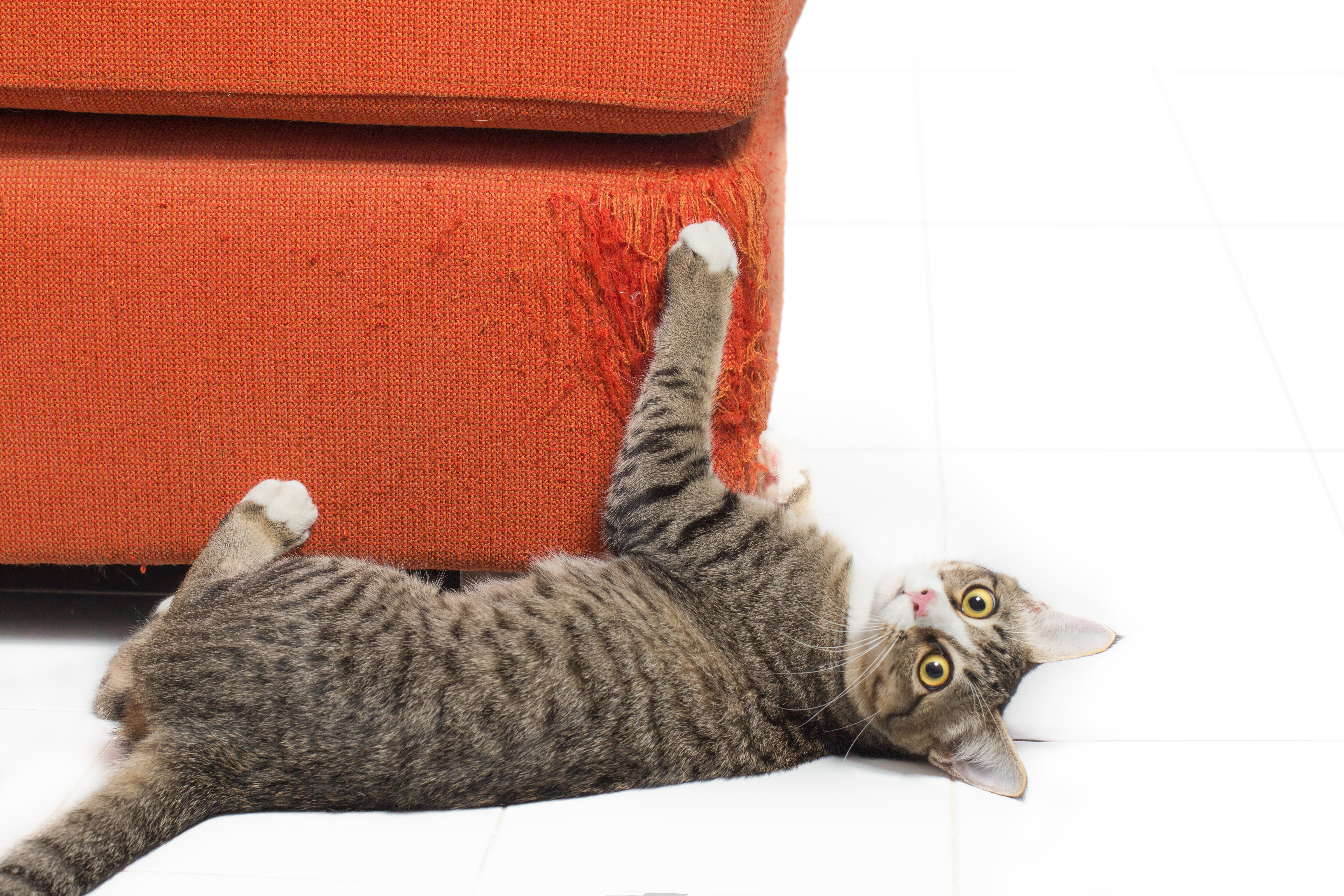
To further protect your furniture from unwanted scratching, it's important to make undesired scratching areas unappealing to your cat. This will help redirect their behavior towards appropriate surfaces. Here are some effective strategies:
- Cover the surface: Use double-sided tape, aluminum foil, or plastic sheets to cover the areas where your cat tends to scratch inappropriately. These textures are unpleasant for cats and can deter them from scratching.
- Use deterrent sprays: There are commercially available deterrent sprays specifically designed to discourage cats from scratching certain surfaces. These sprays often have strong scents that cats find unpleasant, such as citrus or vinegar. Apply the spray to the areas you want to protect and reapply as needed.
- Provide alternative texture: Since cats have specific preferences when it comes to scratching surfaces, try offering alternative textures that they dislike. For example, place a carpet runner or a piece of sandpaper on the desired scratching area. The rough texture will discourage your cat from using that surface.
- Make noise or use motion-activated devices: Cats are sensitive to sudden noises and movement. Consider using noise-making devices or motion-activated products near forbidden scratching spots. This could include placing a can filled with coins on top of furniture or using a motion-activated air spray that startles the cat when they approach the targeted area.
- Block access: If possible, prevent your cat from accessing areas where they tend to scratch inappropriately by closing doors or using baby gates. Limiting their access will help break the habit of scratching in those areas.
Remember, it is crucial not to punish your cat for inappropriate scratching as this may lead to stress and anxiety which can worsen the problem. Instead, focus on making undesired areas unappealing while providing attractive alternatives.
Consistency is key when applying these techniques. Reinforce positive behaviors by rewarding your cat when they use appropriate scratching surfaces and offering praise or treats. With time and patience, your cat will learn to associate the designated scratching surfaces with positive experiences.
By making undesired scratching areas unappealing and providing attractive alternatives, you can successfully redirect your cat's scratching behavior and protect your furniture.
Use positive reinforcement and rewards
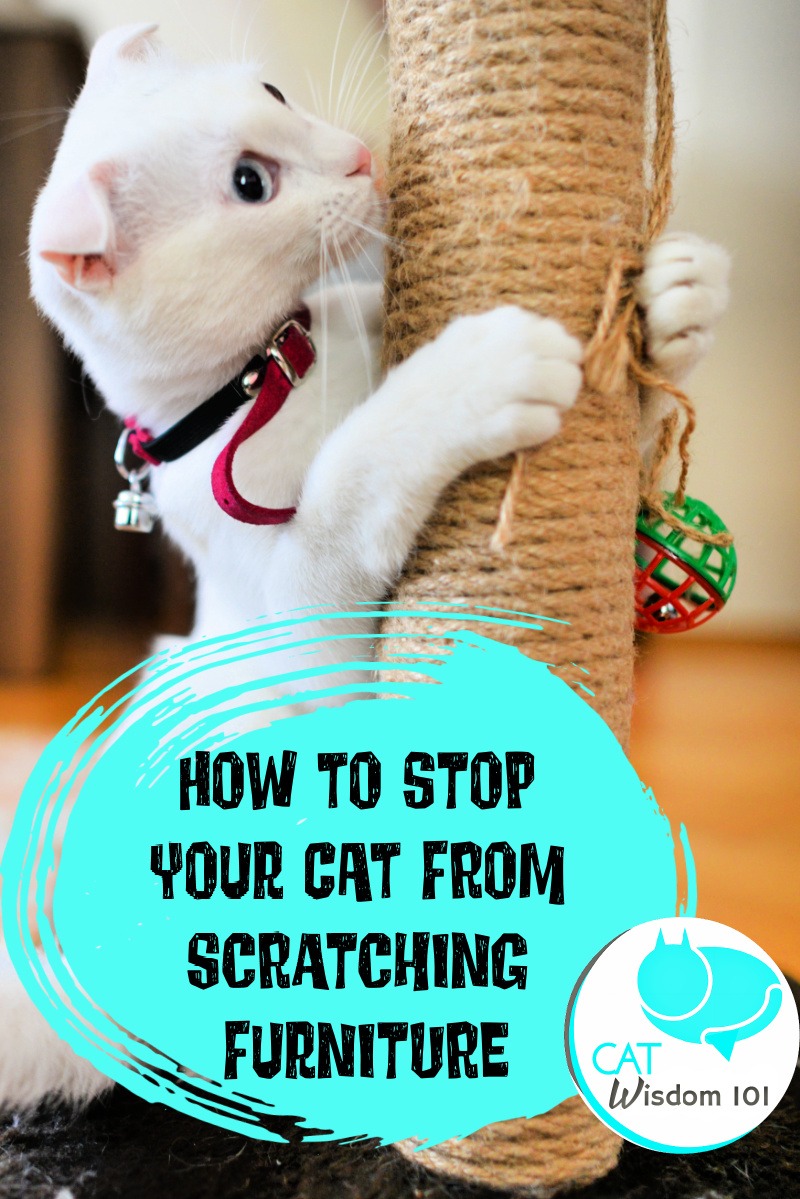
To effectively train your cat to scratch in appropriate areas, it's crucial to utilize positive reinforcement and rewards. Cats respond well to positive experiences, so by rewarding them for using designated scratching surfaces, you can encourage and reinforce the desired behavior.
When your cat uses an appropriate scratching surface, immediately provide praise and affection. Use a happy tone of voice and offer gentle pets or scratches to show them that their behavior is appreciated. You can also give them a small treat as a reward. By associating scratching the appropriate surfaces with positive experiences, your cat will be more likely to continue using those areas.
Additionally, consider using interactive toys or play sessions as rewards for your cat's good behavior. Engage in interactive playtime after they use the appropriate scratching surfaces. This not only provides mental and physical stimulation but also helps redirect their attention away from furniture or other forbidden areas.
Consistency is key when it comes to positive reinforcement. Make sure to consistently reward your cat for using the designated scratching surfaces. Be patient and repeat this process over time until it becomes a habit for your cat.
It's important not to punish or scold your cat if they scratch inappropriately. Punishment can create fear or anxiety, leading to further behavioral issues. Instead, focus on redirecting their attention towards the appropriate surfaces and reinforcing positive behaviors.
If you're having difficulty getting your cat to use the designated scratching surfaces even with positive reinforcement and rewards, consider consulting a professional animal behaviorist or veterinarian specializing in feline behavior. They can provide additional guidance and tailor a training plan specific to your cat's needs.
By using positive reinforcement and rewards, you can effectively train your cat to scratch in appropriate areas while strengthening the bond between you and your feline companion. Remember to be consistent, patient, and understanding throughout the training process. With time and practice, your cat will learn where they are allowed to scratch, keeping your furniture protected in the process.
Distract and redirect your cat's attention
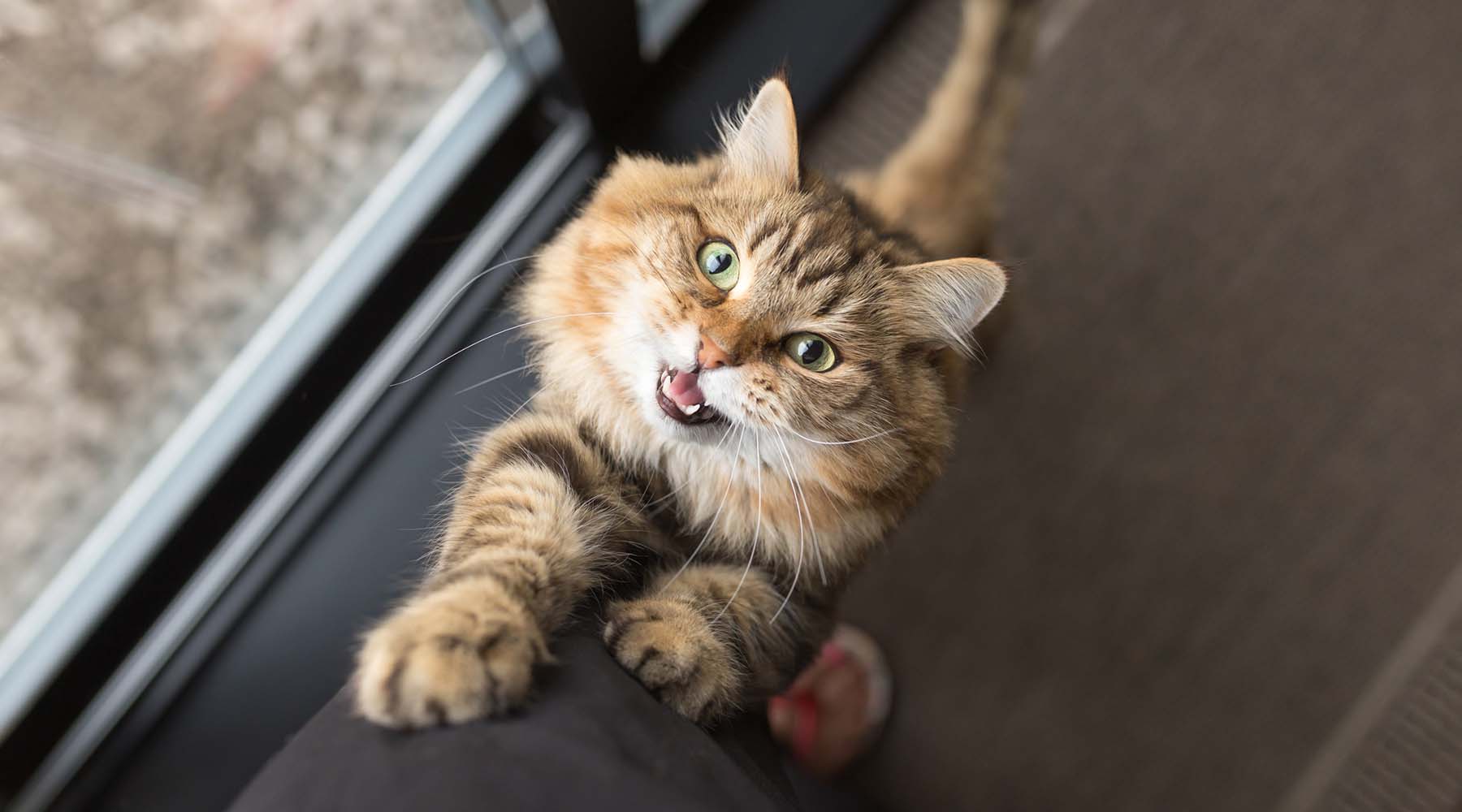
To prevent your cat from scratching in inappropriate areas, it's important to distract and redirect their attention towards more suitable options. This technique helps to shift their focus away from destructive behavior and redirect it towards designated scratching surfaces.
One effective method is to use interactive toys and play sessions. Engaging your cat in play can help release pent-up energy and provide mental stimulation, which can reduce their desire to scratch furniture or other undesirable items. Keep a variety of toys that appeal to your cat's interests, such as puzzle toys or feather wands, and use them strategically during times when they are prone to scratching.
When you notice your cat starting to scratch somewhere they shouldn't, gently intervene by clapping your hands or making a loud noise. This startles them without causing harm, grabbing their attention and redirecting them away from the forbidden area. Once their focus has shifted, immediately guide them towards an appropriate scratching surface, such as a scratching post or cardboard scratcher.
You can also make the designated scratching surfaces more enticing by using catnip or spray attractants specifically designed for this purpose. Sprinkle some catnip on or near the preferred scratching areas to encourage your furry friend's interest. Alternatively, you can try using pheromone sprays that mimic feline facial pheromones, creating a comforting environment for your cat and encouraging them to scratch in those particular spots.
Consistency is key when employing distraction and redirection techniques. Be vigilant in monitoring your cat's behavior and intervene promptly whenever they show signs of scratching inappropriately. Redirecting their attention consistently over time will help reinforce the desired behavior of using appropriate scratching surfaces.
In addition to distraction and redirection, consider providing alternative outlets for exercise and mental stimulation for your cat. Make sure they have access to vertical spaces like climbing trees or shelving units where they can survey their territory. Offer interactive toys or food puzzles that engage their hunting instincts and keep them mentally stimulated. Ensuring your cat is engaged and entertained can help redirect their attention away from destructive scratching behavior.
Remember, patience and consistency are crucial when using distraction and redirection techniques. With practice, your cat will learn what behavior is acceptable and will gravitate towards the designated scratching surfaces instead of your furniture or belongings.
Trim your cat's nails regularly
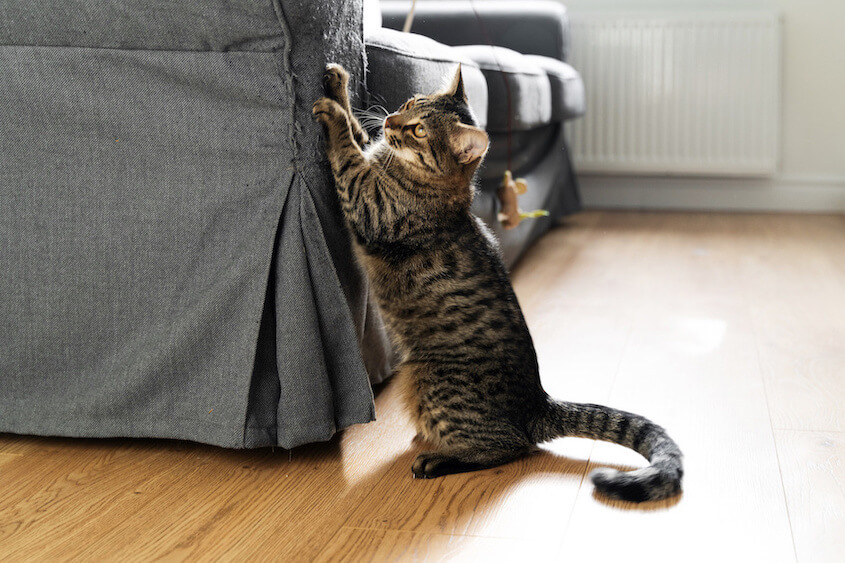
Trimming your cat's nails regularly is an important aspect of their overall nail care and can help prevent unwanted scratching damage to your furniture and belongings. By keeping their nails trimmed, you can ensure that they are not excessively sharp or long, reducing the risk of unintentional scratches.
To trim your cat's nails, it is essential to use proper cat nail clippers or human nail clippers with a straight edge. Avoid using scissors or other sharp instruments that could cause injury. Find a calm and quiet area where you can comfortably handle your cat without distractions.
Before starting the nail trimming process, familiarize yourself with the anatomy of the cat's nail. Look for the translucent portion called the quick, which contains blood vessels and nerves. Be careful not to cut into the quick as it can cause pain and bleeding. If you are unsure how much to trim, consult with a veterinarian or professional groomer for guidance.
Gently hold your cat's paw and press on the pad to extend their claws. Trim only the pointed tip of each nail in one smooth motion. Take breaks between each nail if needed to keep both you and your cat relaxed during the process. If your cat becomes stressed or agitated, consider taking a break and trying again later.
Some cats may be resistant to having their nails trimmed, especially if they have had negative experiences in the past. In these cases, it may be helpful to gradually introduce them to the process by first getting them comfortable with having their paws touched and gradually working up to actual trimming sessions. Make sure to reward them with treats or praise after each successful trimming session to associate positive experiences with nail care.
If you find it challenging to trim your cat's nails on your own, consider seeking assistance from a professional groomer or veterinarian who can provide guidance and ensure proper nail care for your furry friend.
In addition to regular trimming, providing appropriate scratching surfaces such as scratching posts or trees can also help naturally wear down your cat's nails. By both trimming and providing suitable scratching options, you can effectively protect your furniture while maintaining the health and well-being of your cat.
Consider alternatives to scratching

When it comes to protecting your furniture and belongings from your cat's scratching behavior, it's important to consider alternatives to scratching. Here are some options that can help redirect their natural instincts and prevent damage to your prized possessions.
- Provide alternative scratching surfaces: Cats have a natural urge to scratch, so it's important to provide them with appropriate alternatives. Invest in a sturdy scratching post or tree that is tall enough for your cat to fully stretch out and scratch. Make sure the material on the post is appealing to your cat, such as sisal rope or cardboard.
- Use deterrent sprays: If you have undesired scratching areas in your home, you can use deterrent sprays specifically designed for cats. These sprays emit an odor that cats find unpleasant, discouraging them from scratching in those areas. Be sure to test the spray on a small and inconspicuous area first to ensure it doesn't stain or damage your furniture.
- Apply double-sided tape or aluminum foil: Cats dislike the sticky texture of double-sided tape and the crinkling sound of aluminum foil. By placing these materials on the edges of furniture or other targeted areas, you can deter your cat from scratching there.
- Opt for furniture covers or protectors: If you have certain pieces of furniture that are particularly vulnerable to scratches, consider using protective covers or guards. These can help shield your furniture from sharp claws while still allowing your cat to roam freely.
- Provide interactive toys: Engaging your cat in playtime with interactive toys can help redirect their energy away from unwanted scratching behaviors. Toys that mimic prey-like movements or have dangling strings can keep them entertained and mentally stimulated.
- Try nail caps: Nail caps are tiny caps made of soft material that you can apply over your cat's nails. They prevent their claws from causing damage while still allowing them normal movement and function. Consult with your veterinarian about the appropriate application and use of nail caps.
Remember, consistency is key when introducing alternatives to scratching. It may take time for your cat to adjust and learn that these alternatives are more appealing than your furniture. Be patient, and always provide positive reinforcement when your cat uses the appropriate scratching surfaces or engages with alternative toys. With time and training, you can help redirect your cat's scratching behavior and protect your furniture at the same time.
Monitor and supervise your cat
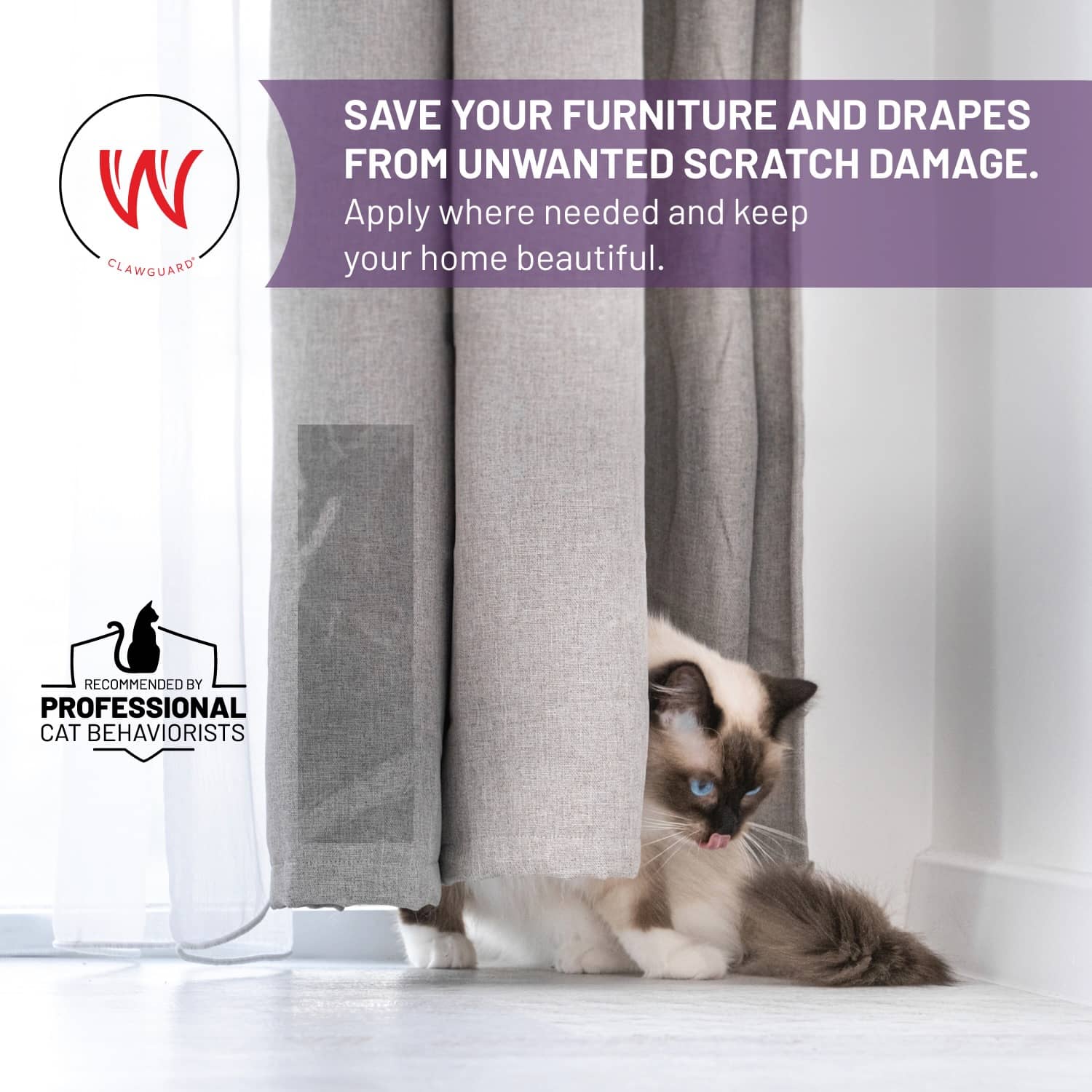
It is essential to monitor and supervise your cat when they are showing signs of scratching behavior. By keeping an eye on your furry friend, you can prevent them from damaging your furniture and redirect their focus to appropriate scratching surfaces.
One way to monitor your cat is by observing their behavior and identifying any patterns or triggers for scratching. For example, if you notice that your cat tends to scratch after waking up from a nap or during playtime, you can anticipate these moments and provide them with alternative options for scratching.
Another effective method is to limit your cat's access to areas where you want to protect your furniture. Use gates or doors to keep them away from rooms or pieces of furniture that are especially susceptible to damage. This will help minimize the chances of destructive scratching occurring in those areas.
Supervising your cat also involves actively engaging with them and redirecting their attention when they start exhibiting scratching behavior in undesirable places. Whenever you catch your cat scratching furniture, calmly but firmly redirect them to their appropriate scratching surfaces. Encourage them to use the designated scratching post or tree by gently guiding their paws towards it and praising them when they follow through.
If you notice persistent scratching habits despite your efforts, consider using deterrents such as noise-making devices or motion-activated deterrents. This can help deter cats from engaging in unwanted behaviors.
Additionally, setting aside dedicated playtime with interactive toys can help release excess energy and reduce the likelihood of destructive scratching. Play sessions not only provide mental stimulation but also act as a healthy outlet for their natural instincts.
Remember that consistency is key in training cats. Reinforce positive behaviors by rewarding your cat with treats or praise whenever they utilize the appropriate scratching surfaces. Positive reinforcement helps solidify the association between good behavior and rewards in your cat's mind.
Overall, monitoring and supervising your cat's behavior allows you to address inappropriate scratching promptly while promoting a positive environment for both you and your feline companion. By understanding their needs, redirecting their attention, and providing guidance, you can effectively protect your furniture and enjoy a scratch-free home.
Seek professional help if needed

If despite your best efforts, your cat continues to exhibit destructive scratching behaviors, seeking professional help can be a valuable step in addressing the issue. A veterinarian or a certified animal behaviorist can provide expert guidance and develop a personalized training plan tailored to your cat's specific needs.
A veterinarian will first conduct a thorough examination to rule out any underlying medical conditions that may be contributing to the scratching behavior. Physical discomfort or ailments such as arthritis or allergies can cause cats to scratch excessively. Treating any health issues can alleviate the urge to engage in destructive scratching.
In some cases, a certified animal behaviorist may be recommended for more specialized assistance. These professionals have in-depth knowledge of feline behavior and can identify any potential underlying psychological factors that may be driving the inappropriate scratching. They can also provide strategies and techniques to modify your cat's behavior effectively.
During a consultation with a professional, they may assess your home environment and suggest modifications that promote appropriate scratching behaviors. They may recommend additional tools such as pheromone sprays or diffusers that create a calming atmosphere for cats, reducing stress-related scratching.
Professional help is particularly beneficial when dealing with severe scratching issues that are causing damage to furniture or posing risks to household members. Behavior modification techniques prescribed by professionals are based on proven scientific principles and techniques that help redirect your cat's scratching instincts towards more suitable surfaces.
It is important to remember that seeking professional help should not be seen as a failure but rather as a proactive step towards finding an effective solution for both you and your cat. With their expertise, professionals can assess the situation objectively and offer specialized guidance tailored to your unique circumstances.
In conclusion, if your attempts at training and redirecting your cat's scratching behavior have been unsuccessful, it may be time to consult with a veterinarian or certified animal behaviorist. These professionals can help identify any underlying medical or behavioral issues and provide targeted strategies for modifying your cat's inappropriate scratching habits. Seeking professional help demonstrates your commitment to ensuring the well-being of your cat and protecting your furniture in the long run.




0 Comments